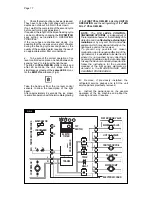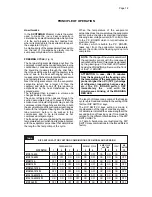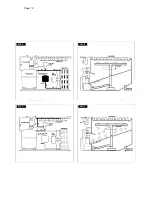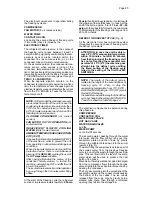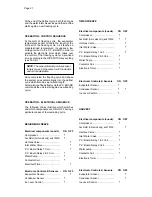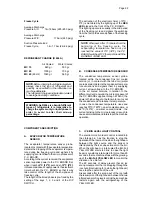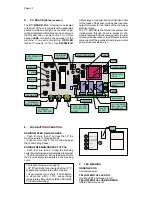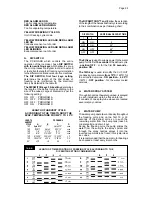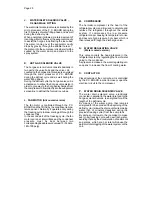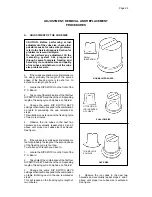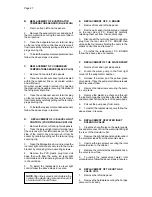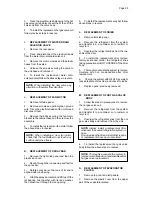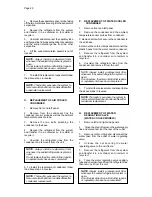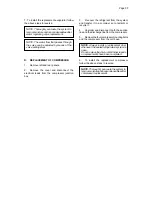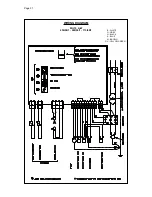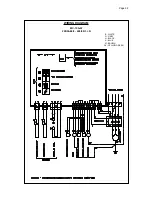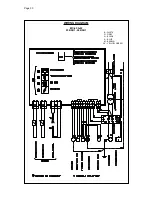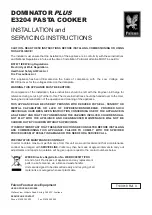
Page 18
Page 18
When the temperature of the evaporator
serpentine drops to a pre-set value, the evaporator
sensor probe changes its electrical resistance
allowing a low voltage current (8-10 volts) to flow
to the P.C. BOARD which in turn activates an
electronic timer.
The timer, which is built-in the P.C. BOARD,
takes over from the evaporator temperature
sensor, the control of the freezing cycle up to its
completion.
NOTE.
The change of the electric potential of
the evaporator sensor with the consequent
activation of the timer (Time mode) is signalled
by the glowing-up of the RED LED located
beside the FREEZING yellow one in the front
of the P.C. BOARD.
ATTENTION. In case, after 15 minutes
from the beginning of the freezing cycle,
the temperature of the evaporator sensor
probe is higher then 0
°
C (32
°
F) (shortage
of refrigerant, inoperative hot gas valve,
etc.) the P.C. BOARD switch OFF
immediately the unit with the
simultaneous blinking of the WARNING
RED LED.
The length of this second portion of the freezing
cycle is pre-fixed and related to the setting of the
first four DIP SWITCH keys.
The DIP SWITCH keys setting is made in
consideration of the type of condenser used.
In Table B are indicated the various lengths of the
second portion of freezing cycle (Time mode) in
relation to the different combinations of the DIP
SWITCH KEYS.
In Table A herebelow are illustrated the DIP
SWITCH key combinations for the three different
factory.
PRINCIPLE OF OPERATION
How it works
In the SCOTSMAN Modular Cubers the water
used to make the ice is kept constantly in
circulation by an electric water pump which primes
it to the self propeller spray bar nozzles from
where it is diverted into the inverted mold cups of
the evaporator (Fig. B).
A small quantity of the sprayed water freezes into
ice; the rest of it cascades by gravity into the
sump assembly below for recirculation.
FREEZING CYCLE (Fig. A)
The hot gas refrigerant discharged out from the
compressor reaches the condenser where, being
cooled down, condenses into liquid. Flowing into
the liquid line it passes through the drier filter,
then it goes all the way through the capillary tube
where, due to the heat exchanging action, it
looses some of its heat content so that its pressure
and temperature are lowered as well.
Next the refrigerant enters into the evaporator
serpentine (which has a larger I.D. then the
capillary) and starts to boil off; this reaction is
emphasized by the heat transferred by the
sprayed water.
The refrigerant then increases in volume and
changes entirely into vapor.
The vapor refrigerant then passes through the
suction accumulator (used to prevent that any
small amount of liquid refrigerant may reach the
compressor) and through the suction line. In both
the accumulator and the suction line it exchanges
heat with the refrigerant flowing into the capillary
tube (warmer), before to be sucked in the
compressor and to be recirculated as hot
compressed refrigerant gas.
The freezing cycle is controlled by the evaporator
temperature sensor (which has its probe in contact
with the evaporator serpentine) that determines
the length of its first portion of the cycle.
TAB. A
DIP SWITCH FACTORY SETTING COMBINATIONS PER MODEL AND VERSION
DIP SWITCH
1
2
3
4
MCS 15-45 A
MCS 15-45 W
MCM 15 A
MCM 15 W
MCM 45-1210 A
MCM 45-1210 W
MCL 15-45-1210 A
MCL 15-45-1210 W
MCXL 45 W
5
6
7
8
9
10
FREEZING CYCLE
DEFROST CYCLE
DEFR. CYCLE
ADD. TIME
15/30
°
ON
ON
OFF
ON
ON
OFF
ON
ON
OFF
OFF
OFF
ON
ON
ON
ON
ON
ON
ON
ON
ON
OFF
OFF
OFF
OFF
ON
ON
OFF
ON
ON
ON
ON
ON
ON
OFF
OFF
OFF
ON
ON
ON
ON
ON
ON
ON
ON
OFF
OFF
OFF
OFF
OFF
OFF
OFF
OFF
OFF
ON
ON
ON
ON
ON
ON
ON
ON
ON
ON
ON
ON
ON
ON
ON
ON
ON
ON
OFF
ON
ON
ON
ON
ON
ON
ON
ON
ON
AIR
WATER
ON
OFF
ON
OFF
ON
OFF
ON
OFF
OFF
Summary of Contents for MC 15
Page 19: ...Page 19 Page 19 ...














